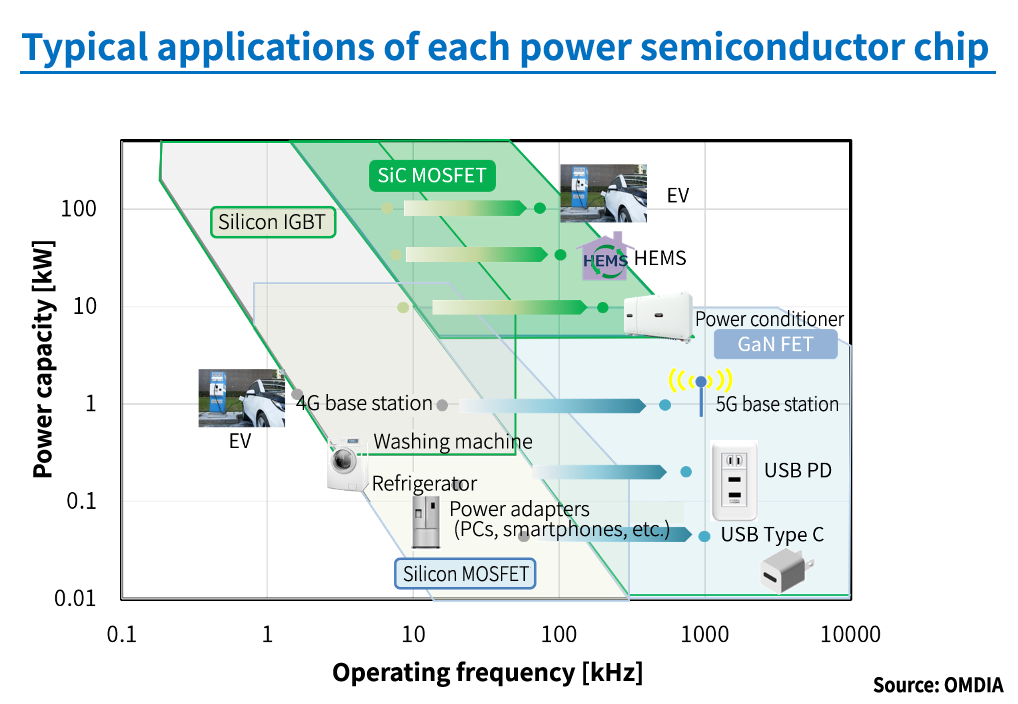CLOSE
About Elements
TANAKA is a leading company in the field of precious metals.
Advanced materials and solutions that support societal progress, the development stories behind them, the voices of engineers, and our management philosophy and vision—
Elements is an online media platform that shares insights that lead to a better society and a more prosperous future for the planet under the slogan “Mastering Precious Metals.”

Evolution of power semiconductors supporting GX promotion and the spread of EVs: A closer look at the current state of the material development supporting its foundation

 Major roles of power semiconductors: power supply control and motor control
Major roles of power semiconductors: power supply control and motor control Power semiconductors reduce power consumption due to the spread of generative AI
Power semiconductors reduce power consumption due to the spread of generative AI Next-generation power semiconductors using “SiC” and “GaN”
Next-generation power semiconductors using “SiC” and “GaN” Expectations for the U.S., China, and India
Expectations for the U.S., China, and India TANAKA Precious Metals maximizes the potential of precious metal materials
TANAKA Precious Metals maximizes the potential of precious metal materials
Every day, we hear about “semiconductors” in the economic news. Among the various types of semiconductors, “power semiconductors,” which are said to be the trump card for decarbonization, are attracting attention. As semiconductors are indispensable for xEVs (general term for “electrified vehicles”) and efficient power consumption, the technological development of new materials is also accelerating.
Through discussions with Akira Minamikawa, a top analyst in the electronics industry, and Naoko Abe, who handles cutting-edge materials for semiconductors as General Manager of the Corporate Communications & Advertising Department of TANAKA Precious Metals, we unraveled the mechanisms, industry trends, and technological development trends behind this.
Major roles of power semiconductors: power supply control and motor control
Right: Akira Minamikawa/ Senior Counseling Director, Informa Intelligence; left: Naoko Abe/General Manager, Corporate Communications & Advertising Department, TANAKA Precious Metals
Naoko Abe (Abe): Nowadays, the semiconductor industry is really booming, with market size and technological development making great strides. Today, I would like to talk intensively about power semiconductors, which have been attracting a lot of attention.
Firstly, please give us an overview of power semiconductors.
Akira Minamikawa (Minamikawa): Power semiconductors are one of the types of semiconductors, and their primary role is to handle and control power.
Other typical semiconductors include microprocessors (CPUs), which have arithmetic functions and are equivalent to the human brain, memory, which stores information, and other types such as sensors, whereas power semiconductors are for “controlling power.”
They are used in various electronic devices and motor controls.
All electronic devices, such as PCs and smartphones, have power supplies, and the role of power semiconductors is to control them.
Since power supplies come in various power sizes, there are a wide range of power semiconductor types.
There are two major roles among power semiconductors. One is to control power supply, specifically voltage regulation and DC-AC conversion.
The other role is motor control. Motors are found in all kinds of products in the world, and power semiconductors are responsible for changing the rotating speed of these motors.
The speed of a car is changed by changing the rotating speed of the motor.
Power semiconductors are responsible for inverter and car motor control. Power supply control and motor control are the two main roles of power semiconductors.
next page Power semiconductors reduce power…
Related Information
Technology Trend and Advanced Packaging Material for Power Device
Power device is key component for a wide range of applications such as smartphones, electronic devices, next-generation mobility including EV and HEV, cellular base stations, power control for renewable energy and so on. Its technology development is thriving day by day.
We introduce advanced packaging technology trends and cutting-edge materials designed to address challenges such as high heat dissipation, high heat resistance, reliable bonding in manufacturing, and miniaturization.
![]()













